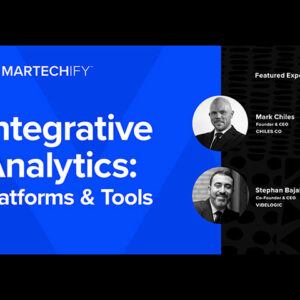Session Recap
Martech Stacks: Fitting the Pieces Together
May 11, 2023 – During this Martechify session, three of today’s leading martech experts shared valuable insight, advice, and best practices on the makeup and journey of a martech stack.
This engaging forum, moderated by Rich Herbst of Ascend Marketing, included Andreas Hjalber of BlueJeans by Verizon, Benjamin Murray of Cradlepoint, and Maxine Eiland, formerly of Okta.
Designed as an extension of February’s forum on the martech stack evolution and the latest trends, the panel covered essential martech stack topics, such as the importance of having governance, well-defined metrics, and alignment on business goals before investing in new tools.
If you missed the event—or want a refresher of the discussion—read the summary below for the highlights, or click below to watch the video of the entire event.
Featured experts
Hitting the high points: Key expert takeaways
Navigating the martech map
The martech landscape has expanded exponentially in recent years, with 11,000 separate technologies available from tech stacks today. With such a daunting number of tools—and new ones constantly emerging—where do you even start?
Our experts noted several crucial pieces of information that you must have as a starting point, whether you are building a stack from the ground up or inheriting tech tools that were selected and set up by other people.
- Have a clear understanding of the stack you have right now, especially if you have inherited it through a new role. What phase of maturity is it in? Is there documentation and data to leverage when deciding on keeping the current tech stack tools or adding/pivoting to others?
- Assess whether the stack is fully implemented, integrated, and resourced with a properly trained team.
- Create a roadmap for the next three, six, and nine months. Is the current stack aligned with your business goals? Can it get you where you want to go?
Even with the right information and a strong foundation in place, the complexities of tech stack deployment, implementation, evolution, and management create many opportunities for things to go wrong. These include mid-implementation organizational challenges, like role or leadership changes. Data silos can prevent reporting accuracy as well as alignment of goals and purposes. These and many other shifting factors and moving parts mean that a “set-it-and-forget-it” approach won’t ensure that your stack is working at its full capacity.
Plan before you buy—Maxine Eiland
The excitement over the latest martech tool can overshadow the less exciting part of growing your stack: taking the time to plan. Martech expert Maxine Eiland emphasizes the importance of planning—and specifically the governance piece of planning—before purchasing any new technology. She recommends answering four questions that can help you avoid investing in a tool that your business doesn’t need or may not be the right fit in the long run.
4 Questions to ask before investing in new tech
- Clearly define ownership with one main point person who oversees the tool on a day-to-day basis.
- Line up two back-up people and confirm that there is thorough documentation of how the system works as well as vendor contacts.
- Find an executive sponsor—someone who understands the value of the technology and can protect it in the short- and long-term.
Have you assessed other tools?
- Assess competitors both internally and externally.
- Determine if there are any existing tools that could be extended or repurposed instead of purchasing a new one.
- Understand the larger landscape—stay on top of the technology being used and what new tools are coming out.
What is the roadmap?
- Buy for your needs now, understanding what growth will look like.
- Consider whether the tool will be able to expand with the company or will likely need to be replaced in the future.
- Look at the impacts on your business of buying this technology, both positive and negative, to ensure it is the right fit now and over the next 6 to 12 months.
- Map out the key features and capabilities and plan the implementation ahead of time so the tool is functioning at its full capacity.
- Prioritize learning to understand what’s working and what’s not, and pivot as needed.
- Work with other teams who need to be involved in implementation and integrations so they can plan ahead and free up necessary resources.
- Be aware of the upcoming features for the tool and how they may fit your needs and benefit your team.
How will you know if it is working for your business?
- Consider which metrics will be used to measure the success of the tool.
- Hold quarterly internal business reviews to validate its usage.
- Hold quarterly business reviews with the vendor, with the understanding that you should have the right data internally and deeper insight into actual revenue associated with the specific tool.
- Keep an eye on the competition. Are they able to do something better, cheaper, or better suited to your business goals?
- Determine whether you have grown enough to justify pivoting to a new vendor.
Maxine’s key takeaway:
Don’t buy the new, shiny toy without governance in place and ensuring there is support for it.
Build for flexibility—Benjamin Murray
Martech expert Benjamin Murray believes in the importance of aligning business goals with the use of technology and data in order to succeed. He advises having a clear goal and keeping the focus on it throughout the designing and building processes and as you are gathering data and insights into the business and its operations. He also emphasizes the value of aligning on your stakeholders’ benefits and helping them show their successes as well. Those efforts can go a long way when the time comes for buy-in and evaluation.
He notes a common challenge among marketers: Fighting the concept of marketing as a cost center versus a revenue generator. But the stack and the data give them the ability to change this perception. That power to change people’s minds should help you stay focused on business goals and the revenue-building mindset that will help move the needle.
With the countless challenges faced by today’s marketers, how can you stay focused on your goal? Benjamin shares his advice for staying on course:
Embrace an agile methodology
He stresses the importance of having an agile mentality as you build and document how the systems connect. That mindset gives you the flexibility to build around the many inevitable changes in business plans, budgets, leadership, and other factors, to minimize the cost and impact of those changes.
Narrow the focus
Building around 3 to 5 core systems in your stack and ensuring that they work well together creates a consistent source of truth and a reliable foundation for your data, which is monumental to achieving long-term goals, not just short-term successes.
Support business goals with core systems
Your core systems support your business purpose and goals. For example, if your business is B2B, your core systems will be heavy on CRM, and focusing on that will help keep your accounts and opportunities in place.
Don’t overlook other core components
Understand the importance of other core components, such as data warehouses, campaign hierarchy, and request tools. The data warehouse and where you store your data is essential. Additionally, the way that you extract data and use it is incredibly important. Campaign hierarchy and request tools leave breadcrumbs along with your data so you can match your source systems to your reports, help draw insights, and do roll-ups to get closer to the ROI (return on investment) of marketing initiatives.
Understand your data end-to-end
Know how your data flows through your environment—from the source systems where you are gathering data to categories, or buckets of information used in reporting, to your output dashboards. Being focused on how your data flows, moves, and groups end-to-end is important to build in agility and flexibility and not be constrained by your systems. As you are adding systems and building onto your stack, make sure you can connect the dots from end to end.
Use the right data approach for reporting
Use the data approach that lines up with the stakeholder request to tell the story that they are trying to tell:
- The Back-to-Front (Source to Report) approach starts with the information you are currently able to see and the insights you can derive from it. The benefit is the ability to provide faster insights with data from connected systems. The drawback is that the current data available is not always aligned with the request, causing gaps.
- The Front-to-Back (Report to Source) approach starts with the stakeholder request or requirements and works backwards to find the right information. While this approach provides greater alignment to stakeholder requests, the data you need may not be available, creating a data gap that may take time and/or new platforms to fill.
Optimize your stack
Stack optimization enables you to build it into what you need to fit the business goal and vision. Achieving it takes a balance of creativity and pragmatism to make sure all the pieces of your core systems connect well and speak the same language. It also takes knowing when enough is enough. Keep in mind that tech in a stack is not addictive—and, in fact, add-ons can create more disconnects and difficulties than advantages.
Determine a direction and build momentum
To set a realistic vision for the business, you must evaluate the team’s strengths and skills alignment. You may find that you don’t have all the skills you need on your team today—don’t be afraid to reach out for outside help. There are partners, like Ascend Marketing, who can fill skill and knowledge gaps and help you get started, build momentum, and keep going.
Set milestones to help you stay on track and keep your sights on what you intended to do. It is equally important to manage progress and the perception of progress, as the complexity of building and developing a tech stack is not always understood by stakeholders. Look for ways to show progress in a way they can appreciate—which sometimes means giving them small, shiny wins while making sure they see the benefits to your system.
Know your audience
Understanding what your audiences are looking for is crucial for success. Make sure you know who your stakeholders are, what their goals and KPIs are, and what is important to them for buy in. That information allows you to push the story they want back to them so that, in turn, they can tell it to other decision-makers.
The significance of storytelling—Andreas Hjalber
Expanding on the idea of using reporting as a tool to tell the story of the data to stakeholders and external audiences, martech expert Andreas Hjalber highlights the importance of establishing a single source for reporting to tell the story consistently and accurately.
Consistency and accuracy can be compromised by data manipulation, data consolidation, and data cleanup in different stages of the data flow through your tech stack. That makes transparency and documentation of exclusion lists (such as internal test data and competitor data) that should never arrive in your source of truth vital to the integrity of the story.
Andreas addresses buy-in and the role of the data and insights you are providing to the team, which is to build the reputation of your external stakeholders. They are used to identify the successes of the business, so alignment on the definition of what a KPI is or what a “success” is becomes critical to the story.
Data consumption—Fighting bias
Establishing KPIs is iterative—they need to be continually re-established as some data sets may not exist in the current stack. In that case, stakeholders need to agree to KPIs that can be measured with the current data set. Otherwise, inconsistencies in data may lead to the bias you deliver from different systems that don’t align.
Issues start when people try to shape the data in their favor, whereas the source of truth is telling them something a little bit different. It is important to know that not all your stakeholders are ever going to agree, and that is the nature of reporting. Complaints over not receiving credit or getting different results from different systems can be avoided by having clear definitions.
Andreas illustrates this point by explaining how the term “lead” may have different definitions to marketing and sales teams. A net new lead to a marketer may be a name with just an email address, phone number, and company that is a net new add to the database. So, if you are being measured on net new leads, it is tempting to buy a list to instantly get a hundred net new adds. That is why it is so important for marketing and sales to clearly define that a net new lead, which, in this example, must be someone new to the database that has one or two follow-up activities to qualify as a legitimate lead.
Accountability is key
Andreas shares that, in his opinion, anything that can’t be reported does not exist. If people want to be held accountable to it, and if their success is going to be aligned to it, it has to be in the system and be easily reported on.
Campaign reporting example—Webinar
He uses a webinar campaign report to illustrate data silos. The core input is probably going to be your web analytics tool, since the registration form is on a webpage and is paired to your marketing automation system. This will collect all the information and sync back the registrations, the attendees, and the no-shows and push it all to your CRM to get those net new leads to your sales teams.
For this example, the KPIs are registrations, attendees, and the conversion rate. But it’s not that simple. You will likely do filtering through your marketing automation system, with data manipulation that addresses employees, competitors, or anyone else you don’t want in the attendee count, resulting in different conversion rates and other markers of “success.” External stakeholders will then tell the story based only on what they saw in the source system, not on the true results. This requires a clearly defined reporting suite with documentation on how you do some of your filtering and why the number of attendees is different depending on how you look at the data.
This brings us back to transparency throughout the entire tech stack. It’s absolutely pivotal, because if people don’t know what you’re doing to the data and when, they won’t trust it and your reputation for good data will be diminished.
Andreas’ key takeaways:
- Build a reporting suite that is clearly defined, easily accessible, and easily defended.
- Create transparency throughout the entire tech stack.
- Eliminate all bias when making changes/investigating requests.
Related resources
New to this topic? Find helpful external links below.
Watch the recording
For more insights and takeaways from the session, watch the full recording here:













